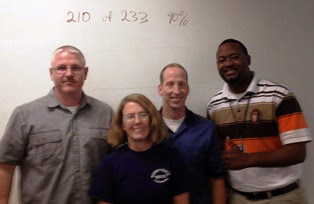What's In A Record?: Improved Statapult Performance

We had a stellar Green Belt class last week. We set a new world record for accurate ping pong balls shot with a catapult in 5 minutes. Team Cinco Amigos (pictured here) hit 210 of 233 shots, breaking the old record of 198 hits. However, the overall profit title went to Team Bombs-R-Us, and the overall yield title went to Team Acme Missiles with 98.4 percent accuracy (3.7 Sigma quality). Team Dead Eye was a honorable mention for also breaking the old world record with 201 of 212 shots. Everyone got A's for the day.
Although Cinco Amigos produced the most hits, they also produced 10% waste and finished behind some of the other teams in other performance areas. The cross-team comparison made me rethink how I emphasize the various instructional points in the curriculum. Because I used the idea of breaking the old world record to introduce the concept of process entitlement, I think I may have encouraged the teams to focus exclusively on productivity measures to the exclusion of qual
